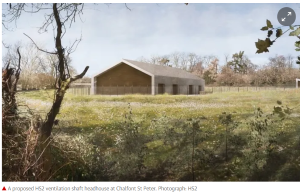 The rail project’s treatment of an area to hide tunnel vent shafts with ‘country barns’ in the Chilterns contrasts with that of council estate in inner London.
The rail project’s treatment of an area to hide tunnel vent shafts with ‘country barns’ in the Chilterns contrasts with that of council estate in inner London.
image: The Guardian – HS2
The Guardian writes:
HS2 is planning to build tunnel vent shaft “headhouses” in the Chilterns disguised as barns to help appease local opposition to the high-speed rail line.
Ministers had long since caved to demands for extra tunnelling so that the line should run underground for most of its passage through the picturesque Chiltern hills. Now, for the few overground structures the tunnel requires, HS2 has unveiled a design that owes more to a farmyard than a railway.
Despite concerns over the estimated £100bn cost of HS2, the company engaged the architects Grimshaw – veterans of the Eden Project and the Oman botanical gardens – to come up with a bespoke building to fit into the local landscape.
The headhouse building at the top of the 60-metre ventilation and emergency access shaft at Chalfont St Peter – the first of four such buildings needed for the 10-mile tunnel – will be a single-storey block “taking its inspiration from the style of local barns … wrapped in a simple pre-weathered grey zinc roof with doors and vent openings picked out in dark bronze”, according to HS2.
Diane Metcalfe, an associate principal at Grimshaw, said the shaft had been “sensitively designed to complement the rural character”, adding: “The pitched roof, zinc-clad buildings are a modern interpretation of the local agricultural and industrial vernacular.”
The buildings will be surrounded by mature trees and fresh saplings to help them blend in, along with bird boxes, reptile basking banks, and a “grass snake laying heap” to help encourage wildlife.
The design was drawn up with input from local residents and the design will now be put out to public consultation.
Rohan Perin of HS2 said: “Once construction is complete, the headhouse at Chalfont St Peter will be one of very few structures of the Chiltern tunnels that will be visible to residents living nearby. That’s why it’s critical that we get the design right.”
Not all neighbours appear to have been treated quite so well by HS2, with remaining residents of a council estate in Camden – where the majority of actual home demolitions have taken place – appealing to be rehoused because of extreme noise, dust and pollution from work that has continued during lockdown.
The route through the Chilterns was one of the most controversial parts of the design of HS2, passing through an area of outstanding natural beauty and a host of Conservative constituencies. Early plans were quickly revised to extend tunnelling in the region, at a cost of an extra £500m.
The government gave formal notice in April to proceed with construction of the first phase of Hs2, linking London and Birmingham. Go-ahead for the entire project was only confirmed in February by the prime minister after a review to examine its scope and mounting costs.

